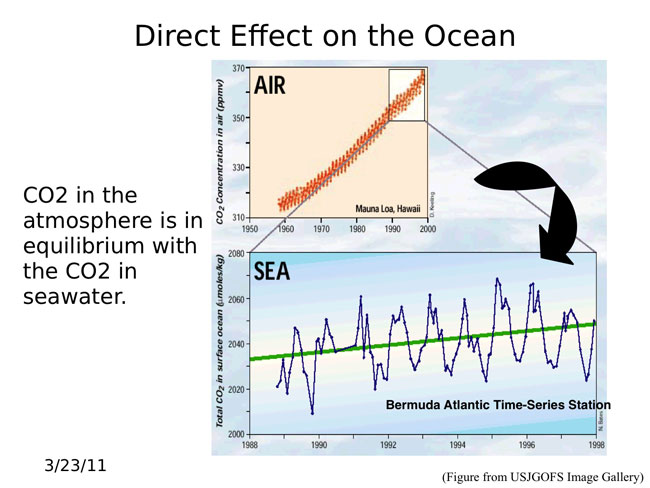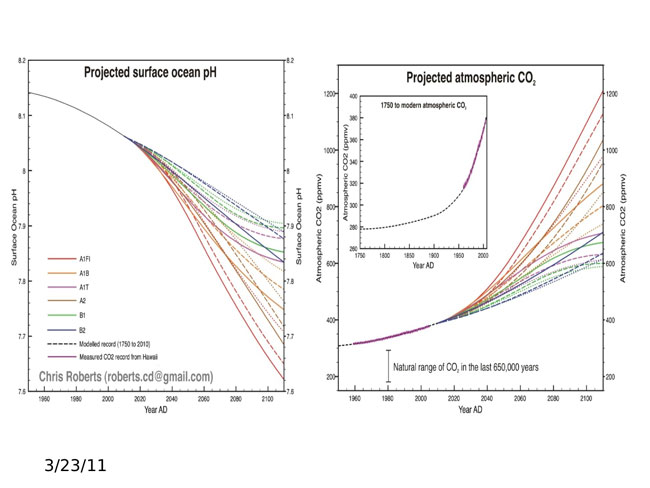Rising Ocean Acidity Presents
Complex Problems
by Mike Crowe and FV Staff
The oceans have not been as
acidic as they are today for the
last 800,000 years.
The burning of fossil fuels and deforestation are causing a dramatic rise in the acidity of the world’s oceans. More than the level of acidity it is the rate of change that has scientists concerned. Carbon dioxide (CO2) concentrations have not changed as rapidly as they have in recent decades for 65 million years.
The carbon dioxide produced from burning coal and oil is pumped into the atmosphere. The oceans in turn absorb about 30 percent of that CO2. The resultant carbonic acid is capable of dissolving the shells of some shellfish and of causing a range of disruptions in the marine environment.
Atmospheric CO2 accumulation and global warming have been common knowledge for 50 years, but scientists are only just beginning to look at these rapid increases in the ocean acidity, the disruptions to marine life, and to consider the possible outcomes.
This issue is not about global warming. There is no debate about CO2 levels rising 1 1/2 parts per million (ppm) every year. It cannot be debated that rising CO2 causes rising acidity in the oceans. Pre-industrial atmospheric CO2 levels were 220ppm, today they are 385ppm.
Marine biologist Mark Green has done research on juvenile clams exposed to marine conditions with elevated acidity. Clam shells in his experiments showed signs of dissolving in 72 hours. Clams placed in sediments with higher acidity fled. The effect of higher acidity is greater on the youngest clams.
Ocean acidity has varied over geologic time, which is measured in of millions of years, but the oceans have not been as acidic as they are today for the last 800,000 years
The effect of this on shellfish varies. Clams, oysters, mussels and bay scallops will take the hardest hit from rising CO2 levels. The shells of lobster and blue crab seem less affected by high acidity. Lobster and crab have something in their shells that clams do not have. This ingredient makes the shell more resistant to the effects of acidity. They also build their shells from the inside, which lessens the impact of acidity.
But since the loss of clams and oysters will also be the loss of organisms on which the lobster and crabs prey, their tougher shells may not protect them from the greater impact of acid water.
Joseph Salisbury, a marine chemist at the University of New Hampshire said that when it comes to ocean acidification, the Gulf of Maine gets a triple threat. First there is the increase in CO2 year after year. Then the GOM is very cold and cold water, like cold soda, absorbs more CO2. The availability of carbonate for shell building is available in a narrow window of warm weather in June and July during spawning season. If the water is more acid, that shell building carbonate will be less available to shellfish. Finally the many rivers along Maine’s coast dump organic matter and water from granitic soils into the Gulf further lowering the pH.
The increased human-driven atmospheric changes began in the 1700s with the burning of coal. Scientists became aware of the change in CO2 levels in the 1800s. At the time it was not considered an environmental problem, but a scientific observation. More recently technology has made it possible to use ice cores to get CO2 data back to about 100,000 years. These ice cores produce accurate data.
Another source of data comes from comparing various isotopes of boron from shell accumulations in coral reefs. From this scientists can get accurate CO2 data from hundreds of millions of years ago.
Computer modelers have predicted that with increased use of fossil fuels and deforestation CO2 levels will be at 750ppm by 2100, said Salisbury. The problem of increased CO2 causing acidification has only been getting a close look for about a decade. How these increases will actually play out and what the consequences will be are effectively unknowns at this time.
Charts showing the CO2 increase in the last 50 years are fairly dramatic. The charts that show a direct and equal relationship between the rise of atmospheric CO2 and the rise in ocean acidity could not be clearer.


Images courtesy of UNH Ocean Process Analysis Lab
As carbon in the atmosphere increases, pressure on the ocean surface increases and effectively drives the carbon into the water. Scientists say the pressure equilibrates as the carbon is absorbed by the ocean. At the same time the carbonates in the ocean are buffering, or neutralizing some of the resultant carbonic acid. The problem is that these neutralizing carbonates are required for building the shell material of coral reefs, clam, oyster, lobster and crab shells.
The complexity of the problem is as complex as the evolution of the animals that will be impacted by these changes. Justin Ries, a professor of marine geology at the University of North Carolina, has written that on marine shells every spinal ridge and curve has evolved to serve some function. Conchs have bumps on their spinal surface to prevent them from spinning endlessly in the currents. Clams are thought to have evolved asymmetrical ridges along their shells outer surfaces to help them wriggle into sediment. In highly acidic water the conch bumps dissolved and the clam ridges became smooth and flat. Will these changes alone be enough to significantly reduce survival rates that will be reflected in lobster and crab prey stocks?
The scientific jury is out on this and a long list of “if-this, then-maybe-thats.” Researchers at the Woods Hole Oceanographic Institute wrote in 2009 that “Societies dependent on marine calcifiers could consequently experience significant economic losses and even social disruptions over the next several decades.” (S.R. Cooley and S.C. Doney, WHOI, January 14, 2009)
Bill Mook of Mook Seafarms in Walpole, Maine, said that looking at the collapse of the oyster industry on the west coast about six years ago should be both a warning and a learning opportunity. That decades old aquaculture industry began to see slower larval responses. The larvae were not setting normally to oysters on the bottom. The largest hatchery there saw a sudden decline of 75 percent.
The dramatic change there was a result of a shift of winds that blew surface waters offshore and brought up deeper more acidic water welling up.
He said they are not seeing acidic changes in Maine now. However, changes to patterns of phytoplankton blooms are a concern since the result can be higher CO2. He also mentioned hints of something in larval growth rates and behavior that make him wonder about the baseline amount of CO2 in the water.
Mook said the goal should be to stay ahead of the curve before conditions reach a critical stage as they did on the west coast. Buffering the water in hatcheries is one thing that could be done. Another is to recognize the effects of rivers on the Gulf of Maine. Rivers bring nutrients, nitrates, phosphates, some natural and some human sources, and water treatment plant out flows. These combine to create phytoplankton blooms that increase CO2.
Mook said the GOM is different from the west coast. The sources of CO2 are more riverine n the GOM than from deep upwelling ocean water. But he said, “there is no chance to stave off economic disaster if we don’t make the effort to understand the problem.”
